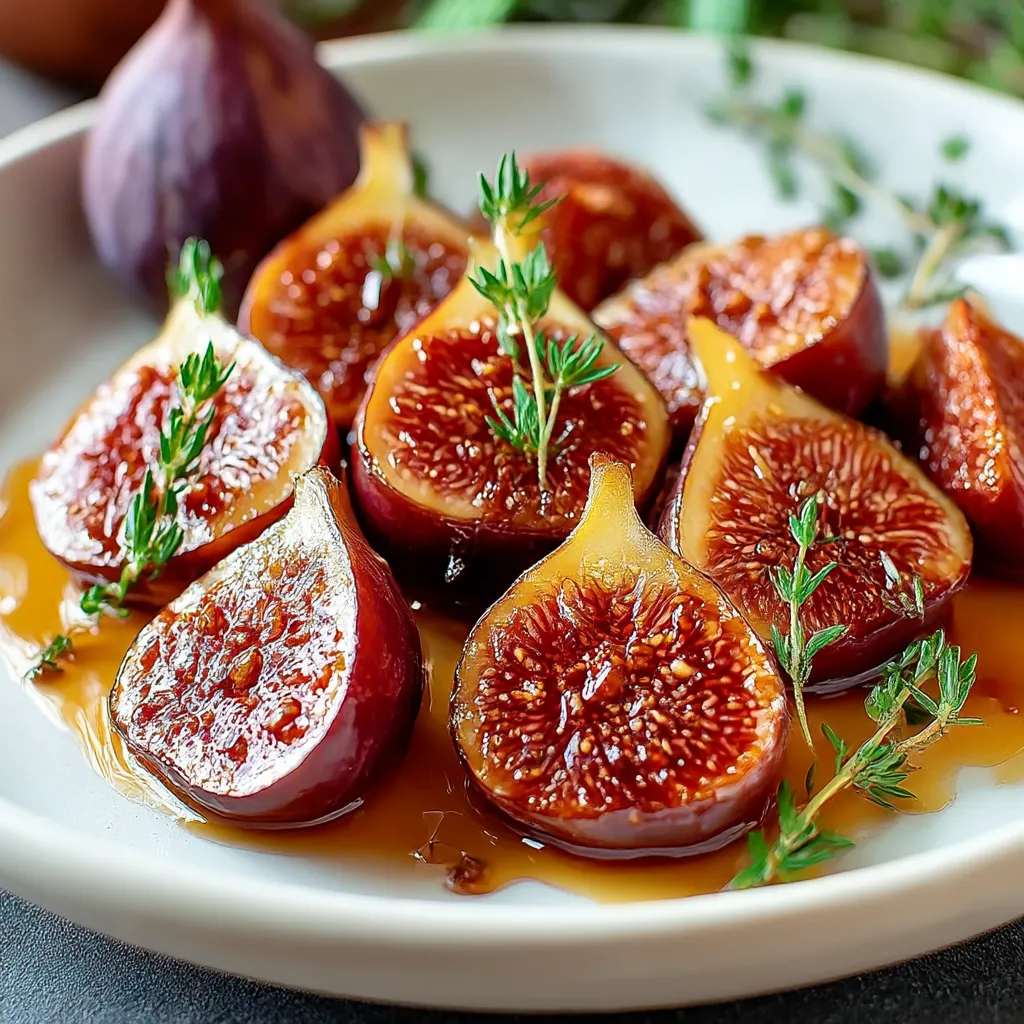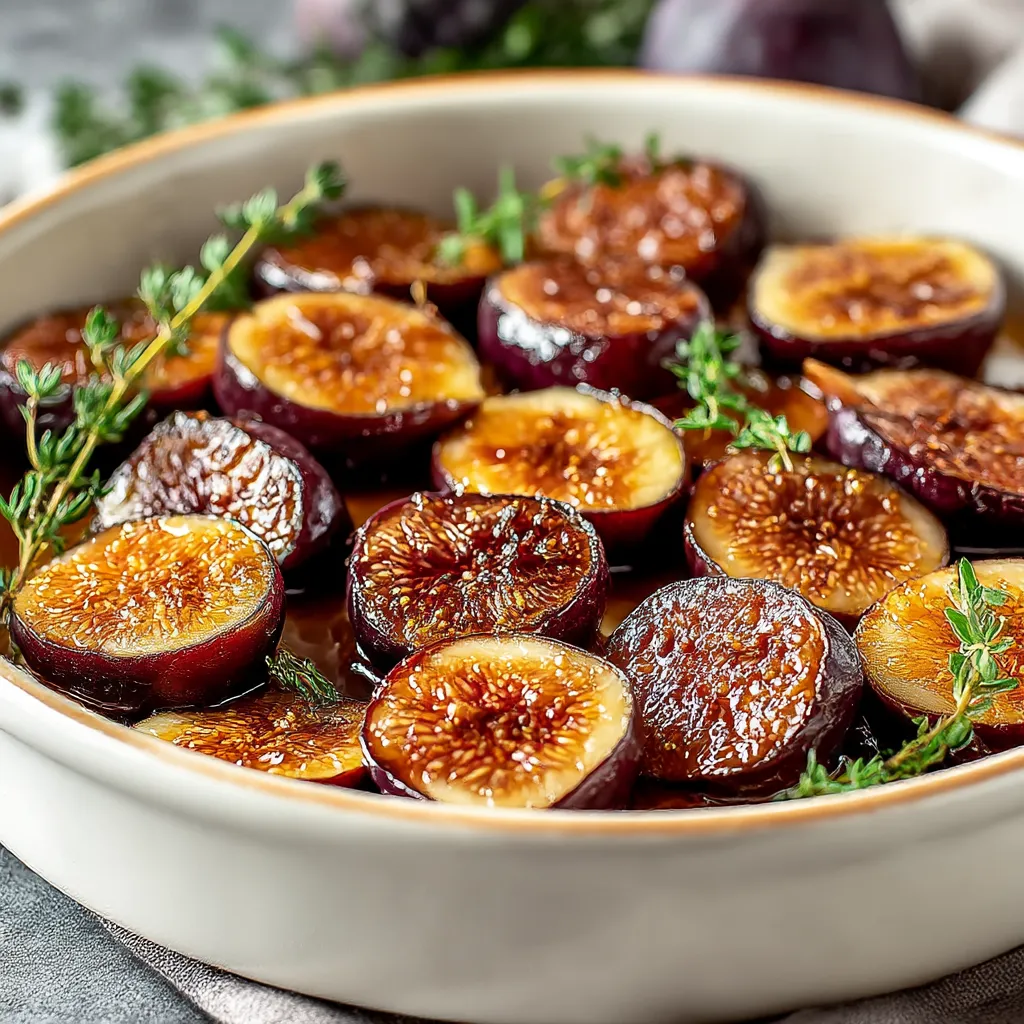 Save
Save
This simple roasted fig recipe transforms an already delicious fruit into a caramelized, aromatic treat that balances natural sweetness with rich depth. The honey-balsamic glaze brings out the figs' natural flavors while creating an irresistible caramelization that makes this dessert feel much more sophisticated than its minimal preparation suggests.
I discovered this recipe during a late summer visit to my aunt's fig tree when we were overwhelmed with ripe fruit. What started as a simple solution to fig abundance has become my signature entertaining dessert when I want to impress without spending hours in the kitchen.
Ingredients
- Fresh figs: The star of this recipe. Look for fruits that yield slightly to pressure but aren't mushy. Avoid any with fermented smells or mold.
- Honey: Creates caramelization and enhances natural sweetness. Choose a lighter variety like clover or orange blossom to complement rather than overpower.
- Balsamic vinegar: Adds sophisticated depth and balances sweetness. Quality matters here a good aged balsamic makes a noticeable difference.
- Olive oil: Prevents sticking and helps with browning. Use a mild extra virgin that won't compete with other flavors.
- Sea salt: Just a pinch enhances all the flavors and creates contrast with the sweetness.
- Fresh herbs: Optional but recommended. Thyme or rosemary add aromatic complexity that elevates the entire dish.
Step-by-Step Instructions
- Preheat the Oven:
- Set your oven to 400°F (200°C) and allow it to fully preheat while you prepare the figs. A properly heated oven ensures immediate caramelization rather than slow cooking which can make the figs mushy.
- Prepare the Figs:
- Rinse figs gently under cold water to remove any debris but be careful not to bruise them. Pat completely dry with paper towels as excess moisture will prevent proper caramelization. Make a small cross cut at the top of each fig about halfway down this allows the glaze to penetrate and creates a beautiful presentation when they open slightly during roasting.
- Create the Glaze:
- Whisk honey, balsamic vinegar, olive oil, and salt together until fully incorporated. The mixture should be smooth and pourable. Make sure to break up any honey crystals completely for even distribution over the figs.
- Arrange and Glaze:
- Position figs cut side up in a single layer on your baking sheet or dish with space between each fruit. Pour the glaze mixture carefully over each fig, ensuring some gets into the cross cuts. Use a spoon to redirect any pooled glaze back onto the figs.
- Roast to Perfection:
- Place the baking dish in the center of your preheated oven and roast for 15-20 minutes. Watch carefully around the 15-minute mark as oven temperatures vary. The figs are done when they've softened visibly, begun to open slightly at the cuts, and the glaze has thickened and caramelized around them.
- Rest and Serve:
- Allow the figs to rest for 3-5 minutes after removing from the oven. This allows the juices to settle and the glaze to thicken slightly. Serve warm with any remaining glaze from the pan drizzled over top.
 Save
Save
The balsamic vinegar is my secret weapon in this recipe. I once tried to skip it thinking the honey would be enough, but the depth and complexity was completely missing. That slight tang is what makes people ask for the recipe every single time.
Serving Suggestions
These roasted figs truly shine when served warm with a dollop of mascarpone, Greek yogurt, or vanilla ice cream. The contrast between the warm, jammy figs and cold creamy topping creates a perfect balance. For a more sophisticated dessert, try drizzling with a small amount of port wine or nocino (walnut liqueur) before serving.
Perfect Pairings
Roasted figs make an exceptional addition to a cheese board. Serve alongside aged cheeses like Manchego, Parmesan, or a creamy blue cheese. The sweet-savory combination works beautifully with a glass of dessert wine like Sauternes or a tawny port. For a memorable brunch, serve atop sourdough toast spread with ricotta and drizzled with honey.
Seasonal Variations
While Black Mission figs are most common, experiment with different varieties when available. Brown Turkey figs tend to be milder and work beautifully with warming spices like cinnamon and cardamom. Green Kadota figs have a more delicate flavor that pairs wonderfully with citrus zest added to the glaze. During winter months when fresh figs aren't available, you can adapt this recipe using halved pears or peaches with excellent results.
Storage Tips
These roasted figs are best enjoyed immediately, but leftovers can be refrigerated in an airtight container for up to 3 days. Reheat them gently in a 300°F oven for 5-7 minutes or microwave on 50% power in short bursts until just warmed through. The caramelized figs also make an excellent refrigerator jam when chopped and stored with their glaze—spread on toast or stir into yogurt.
Recipe FAQs
- → What kind of figs work best for roasting?
Black Mission or Brown Turkey figs work exceptionally well for roasting as they maintain their shape while becoming perfectly tender. Choose figs that are ripe but still firm to the touch for best results. Overly soft figs may become too mushy during the roasting process.
- → Can I make this dish with dried figs instead of fresh?
Fresh figs are recommended for this roasting method, as they caramelize beautifully and develop a tender texture. If using dried figs, they would need to be rehydrated first by soaking in warm water for 30 minutes, but the end result will have a different texture and flavor profile than using fresh figs.
- → How do I store leftover roasted figs?
Store leftover roasted figs in an airtight container in the refrigerator for up to 3 days. They can be enjoyed cold, but gently reheating them in the microwave for 20-30 seconds or in a 300°F oven for 5 minutes will restore their warm, tender texture.
- → What can I serve with these roasted figs?
These versatile roasted figs pair beautifully with Greek yogurt, ice cream, or mascarpone for dessert. For a savory application, serve alongside cheese boards, particularly with blue cheese or goat cheese. They also complement roasted meats like lamb or pork, and make an elegant addition to breakfast with granola or toast.
- → Can I prepare the figs in advance for a dinner party?
Yes! You can prepare the figs up to the point of roasting several hours in advance. Arrange them in your baking dish, cover with plastic wrap, and refrigerate. The honey-balsamic mixture can also be prepared ahead and kept separate. When guests arrive, simply drizzle the glaze over the figs and roast them for a fresh-from-the-oven treat.
- → Are there any alternatives to balsamic vinegar in this dish?
While balsamic vinegar provides a distinctive flavor, you can substitute with port wine, marsala, or a fruit-based vinegar like raspberry or fig vinegar. For a non-alcoholic alternative, try pomegranate molasses or a splash of fresh orange juice mixed with a small amount of apple cider vinegar.
